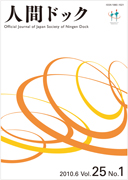Volume 25, Issue 1
Displaying 1-16 of 16 articles from this issue
- |<
- <
- 1
- >
- >|
Foreword
-
2010 Volume 25 Issue 1 Pages 5-6
Published: 2010
Released on J-STAGE: February 28, 2013
Download PDF (375K)
Review
-
2010 Volume 25 Issue 1 Pages 9-20
Published: 2010
Released on J-STAGE: February 28, 2013
Download PDF (6089K) -
2010 Volume 25 Issue 1 Pages 21-29
Published: 2010
Released on J-STAGE: February 28, 2013
Download PDF (5585K)
Original Articles
-
2010 Volume 25 Issue 1 Pages 32-37
Published: 2010
Released on J-STAGE: February 28, 2013
Download PDF (1162K) -
2010 Volume 25 Issue 1 Pages 38-43
Published: 2010
Released on J-STAGE: February 28, 2013
Download PDF (1246K) -
2010 Volume 25 Issue 1 Pages 44-49
Published: 2010
Released on J-STAGE: February 28, 2013
Download PDF (676K) -
2010 Volume 25 Issue 1 Pages 50-54
Published: 2010
Released on J-STAGE: February 28, 2013
Download PDF (588K) -
2010 Volume 25 Issue 1 Pages 55-59
Published: 2010
Released on J-STAGE: February 28, 2013
Download PDF (425K) -
2010 Volume 25 Issue 1 Pages 60-64
Published: 2010
Released on J-STAGE: February 28, 2013
Download PDF (1649K) -
2010 Volume 25 Issue 1 Pages 65-70
Published: 2010
Released on J-STAGE: February 28, 2013
Download PDF (896K) -
2010 Volume 25 Issue 1 Pages 71-76
Published: 2010
Released on J-STAGE: February 28, 2013
Download PDF (877K) -
2010 Volume 25 Issue 1 Pages 77-83
Published: 2010
Released on J-STAGE: February 28, 2013
Download PDF (1952K) -
2010 Volume 25 Issue 1 Pages 84-89
Published: 2010
Released on J-STAGE: February 28, 2013
Download PDF (910K) -
2010 Volume 25 Issue 1 Pages 90-94
Published: 2010
Released on J-STAGE: February 28, 2013
Download PDF (1271K) -
2010 Volume 25 Issue 1 Pages 95-99
Published: 2010
Released on J-STAGE: February 28, 2013
Download PDF (517K)
Short Report
-
2010 Volume 25 Issue 1 Pages 100-104
Published: 2010
Released on J-STAGE: February 28, 2013
Download PDF (760K)
- |<
- <
- 1
- >
- >|
